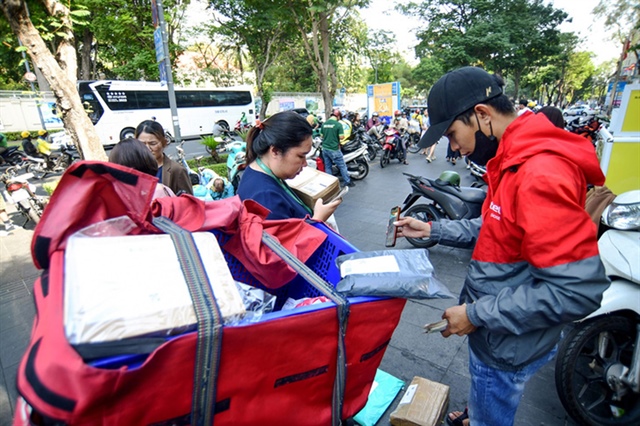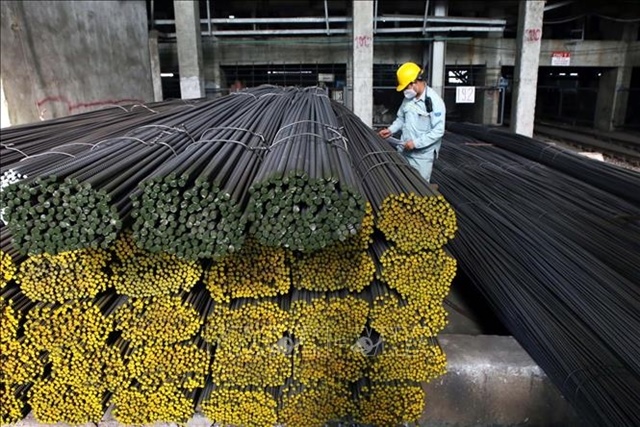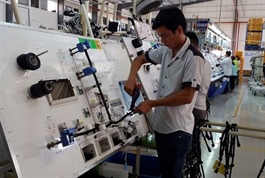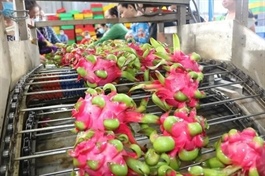Vietnam’s e-commerce growth hindered by weak logistics, expert urges reform
Vietnam’s e-commerce growth hindered by weak logistics, expert urges reform
Vietnam should improve its policies to support the development of bonded warehouses and invest heavily in logistics infrastructure, including data management technologies, in order to give a push to locally-made products on e-commerce platforms amid an influx of Chinese goods into the local market via these channels, said Nguyen Xuan Hung, an expert from the Vietnam Logistics Business Association.

A courier (R) delivers goods to a consumer in District 1, Ho Chi Minh City. Photo: Quang Dinh / Tuoi Tre |
Given the development of e-commerce, it is vital for Vietnam to invest in logistics infrastructure and improve related legal frameworks if the country hopes to compete with regional and international rivals, Hung said in an interview with Tuoi Tre (Youth) newspaper.
Bonded warehouses needed
According to Hung, Chinese goods are typically stored in warehouses in Pingxiang and Hekou, both of which are on the border with Vietnam, allowing for short transport distances into Vietnam.
Since most orders fall below VND1 million (US$40), they are exempt from import taxes and specialized inspections, which significantly cuts costs and reduces transport time.
These warehouses also employ automatic logistics processes, enabling them to minimize errors and increase productivity.
The average cost for a container truck to carry 15,000 orders from China to Vietnam is VND20 million ($800), putting the cost for each order at VND1,400.
Vietnam's e-commerce landscape remains fragmented, and logistics firms serving domestic e-commerce traders are still underdeveloped.
While Vietnamese traders have successfully embraced new technologies like live-streaming promotions, their logistics capabilities lag behind.
This shortfall forces businesses to hire additional employees to fulfill orders, often delaying completion by several days.
In contrast, e-commerce platforms in countries like China can process thousands of orders within an hour.
Transport costs in Vietnam are also higher compared to China, further exacerbating the challenges for local traders.
Chinese logistics companies, including Best, SF Express, and J&T Express, have been quick to capitalize on the Vietnamese market, establishing warehouses and automatic sorting centers that give them a competitive edge over local rivals. These bonded warehouses significantly speed up delivery times.
Amazon has similarly expanded its global reach by opening bonded warehouses in various countries, allowing for quicker order fulfillment and reduced costs for both sellers and buyers.
Currently, Vietnam lacks regulations for establishing bonded warehouses specifically for e-commerce platforms. Existing policies only allow bonded warehouses for the re-export of imported goods within industrial and export processing zones.
Hung suggested that the government revise these regulations to support the development of bonded warehouses, emphasizing the need to standardize production and operation processes.
He also called for increased collaboration between enterprises and tech firms to optimize supply chains. Moreover, government support in the form of tax incentives and land use fee reductions is crucial for fostering growth in this sector.
|
|
| The volume of Chinese goods sold to Vietnamese consumers via e-commerce platforms has soared. Photo: Bong Mai / Tuoi Tre |
China's strong logistics industry
Hung acknowledged that China's support policies for its logistics enterprises and e-commerce platforms have significantly lowered product prices and boosted the competitiveness of its logistics sector.
Many warehouses receive government incentives if they meet specific criteria.
As a case in point, in Shizhong, a district in Zaozhuang City, Shandong Province, the local administration subsidizes 10 percent of overseas warehouse costs if a warehouse developed or leased by a cross-border e-commerce enterprise exceeds 500 square meters and the annual investment surpasses 300,000 renminbi ($42,032).
Similarly, Yunhe District in Zhejiang Province offers incentives for the construction of bonded warehouses.
Enterprises that secure more than two million orders annually and report a year-on-year growth rate exceeding 15 percent receive a subsidy of 0.5 renminbi ($0.07) per order, with the total annual subsidy capped at 150,000 renminbi ($21,016) per enterprise.
According to Hung, China has posted outstanding growth in logistics over the past two years, especially with the Direct-to-Consumer model where brokers have been gradually eliminated.
One method of doing this is by connecting with digital marketing companies to host live-streamed sessions on Facebook and TikTok.
|
|
| Goods from China are classified at a sorting center in Bac Ninh Province, northern Vietnam. Photo: Bong Mai / Tuoi Tre |
Vietnam’s scattered logistics systems
Hung acknowledged that Vietnam’s logistics systems are fragmented, with orders often passing through multiple intermediaries before reaching consumers.
Most Vietnamese businesses only ship orders once or twice a day, leading to delays for any orders placed after those shipment times, which are then deferred until the next day.
Vietnamese logistics enterprises also face significant challenges, including high land rental costs, complex regulations, and a lack of government incentives.
Hung suggested that one potential solution to these issues is for local enterprises to collaborate and create a large-scale centralized logistics model that could share infrastructure and reduce costs.
Vietnam's e-commerce sector has enormous potential, with over 70 million Internet users, 75 percent of whom are online shoppers, which presents a significant opportunity for the growth of e-commerce platforms and online shopping apps.
The Vietnamese market is highly competitive, with platforms like Shopee, Lazada, Tiki, Sendo, and TikTok Shop dominating the landscape.
Vietnamese consumers shop online an average of four times per month, twice the rate in 2023 and double the monthly supermarket visit frequency, according to a report by measurement and data analytics company NielsenIQ Vietnam.
On average, they spend over eight hours per month on online shopping.
Sales on e-commerce platforms in Vietnam were projected to reach nearly $30 billion this year, a 45-percent increase from the previous year.
This would account for approximately 14 percent of the country’s total retail sales of consumer goods and services, according to the Vietnam Industry and Trade Information Center under the Ministry of Industry and Trade.




























